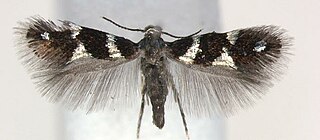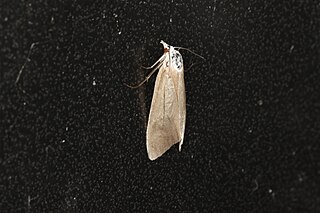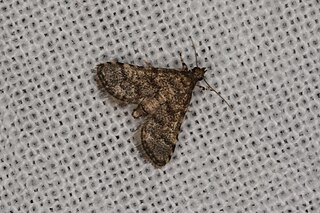
The Heliozelidae, commonly known as shield-bearer moths, are a family of small, day flying monotrysian moths distributed worldwide. The larvae of most heliozelid species are leaf miners who cut distinctive shield-shaped cases from the surface of the host leaf, hence the common name. Some species are considered pests of commercial crops such as grapevines, cranberries, and walnuts. The taxonomy of this family is poorly understood.
Trigonoorda is a genus of moths of the family Crambidae.

Opogona is a genus of the fungus moth family, Tineidae. Therein, it belongs to the subfamily Hieroxestinae. As it includes Opogona omoscopa, the type species of the now-abolished genus Hieroxestis, it is the type genus of its subfamily.

Xyloryctidae is a family of moths contained within the superfamily Gelechioidea described by Edward Meyrick in 1890. Most genera are found in the Indo-Australian region. While many of these moths are tiny, some members of the family grow to a wingspan of up to 66 mm, making them giants among the micromoths.
Corynophora torrentellus is a moth in the family Crambidae. It was described by Edward Meyrick in 1879. It is found in Australia, where it has been recorded from Queensland.
Hednota diacentra is a moth in the family Crambidae. It was described by Edward Meyrick in 1897. It is found in Australia, where it has been recorded from Victoria.
Hednota enchias is a moth in the family Crambidae. It was described by Edward Meyrick in 1897. It is found in Australia, where it has been recorded from Tasmania.

Scirpophaga imparellus is a moth in the family Crambidae. It was described by Edward Meyrick in 1878. It is found in Australia, where it has been recorded from Queensland, New South Wales and Victoria.
Scoparia oxygona is a moth in the family Crambidae. It was described by Edward Meyrick in 1897. It is found in Australia, where it has been recorded from Tasmania.
Canuza acmias is a moth in the family Crambidae. It was described by Edward Meyrick in 1897. It is found in Australia, where it has been recorded from New South Wales.
Trigonoorda psarochroa is a moth in the family Crambidae. It was described by Turner in 1908. It is found in Australia, where it has been recorded from Queensland.
Trigonoorda rhodopa is a moth in the family Crambidae. It was described by Alfred Jefferis Turner in 1908. It is found in Australia, where it has been recorded from Queensland and the Northern Territory.
Eusabena paraphragma is a moth in the family Crambidae. It was described by Edward Meyrick in 1889. It is found on New Guinea and Australia, where it has been recorded from Queensland.

Glycythyma chrysorycta is a moth in the family Crambidae. It was described by Edward Meyrick in 1884. It is found in India, Sri Lanka, Myanmar, Japan, Korea, China, Taiwan and Australia, where it has been recorded from Queensland.
Herpetogramma platycapna is a species of moth in the subfamily Spilomelinae of the family Crambidae. It was described by Edward Meyrick in 1897. It is found in Malaysia, Indonesia (Sulawesi), New Guinea, the Keeling Islands and Australia, where it has been recorded from the Northern Territory.

Metasia acharis is a moth in the family Crambidae. It was described by Edward Meyrick in 1889. It is found on New Guinea and Australia, where it has been recorded from Queensland.
Nacoleia parapsephis is a moth in the family Crambidae. It was described by Edward Meyrick in 1887. It is found on New Guinea and Australia, where it has been recorded from Queensland.
Patania aedilis is a species of moth in the family Crambidae. It was described by Edward Meyrick in 1887. It is found in Australia, where it has been recorded from Queensland.





